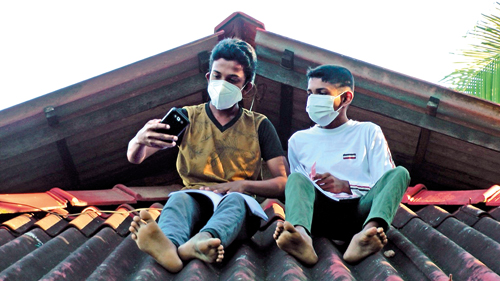Climbing trees to get phone signals
View(s):
Two students sitting on a roof to get a better mobile phone signal.
One fine afternoon around 3 pm, a 4-wheel cab was seen descending through misty mountains and endless bends along the Haputale – Balangoda road. The passenger, occupying the front-left seat appears to be exhausted by the work which he attended since that early morning; he was L. Jayasinghe, a business consultant working for a private business holding in Ratnapura. He was returning to Ratnapura on the same day after a business trip to a tea plantation in Haputale.
Having seen a vegetable stall by the roadside in Haldummulla area, Jayasinghe asked the driver to stop the vehicle to buy some vegetables. It took about 15 – 20 minutes for him to finish his purchases. As he felt a call of nature as well, he thought of relieving himself before getting in the vehicle. He walked down the road for few feet and, then walked away from the road looking for a tree to cover up himself. As he climbed down the hill, mosquitos surrounded him; he thought that there could be leeches as well.
Class in the jungle
Suddenly, he heard a little noise behind the bushes under a nearby tree – it was a little girl of age 12 – 15 years! Sitting on a small bench, she was listening to an “online lesson” through a mobile phone and writing notes on a booklet. Jayasinghe looked around, but there was no sign of a house, neither was anybody else in the vicinity. It was a surprise scene that in the middle of a jungle-like location, a little girl was all alone attending her online class.
As she was so attentive to her lesson, she didn’t notice that there was a stranger behind. Jayasinghe quietly turned back and, he even forgot why he came there. After coming back to the vegetable stall again, he told the vegetable seller: “There is a little child down there all alone listening to online lessons with a hand phone; why is she there?”
The trader answered: “Oh…yes sir; in this whole area, that’s the only place where she can catch the telephone signal. Every day she comes there to listen to the lessons.”
Jayasinghe pulled his mobile phone from his pocket and, checked it. It is true; even on his advanced modern phone, there was just one signal-dot going on and off, indicating weak signal strength.
Jayasinghe’s heart was broken for the child: “How long does the child stay there?”
The trader answered: “One or two hours at a time! Once the battery goes off, she must go back to charge it; her home is over there down the hill. Some days, she comes a couple of times to listen to the lessons.”
He got in the vehicle; throughout his journey all the way back to Ratnapura, from time to time he visualized the child’s picture of attending the online lessons in that lonely place.
Day-classes and night-classes
Since the mid-2020, the universities in Sri Lanka too had to shift their teaching and examinations from onsite mode to online mode. There were university students constantly falling out of their education process mainly due to connectivity issues. During the last semester 6 percent of the students studying in Economics reported that they never participated in “real-time” teaching sessions for any of the courses.
 While most of the students joined the online classes with their mobile phones, one-fourth joined with a computer. Also, about one-fourth of the students have used their home Wifi, whereas the majority joined the classes with mobile data cards.
While most of the students joined the online classes with their mobile phones, one-fourth joined with a computer. Also, about one-fourth of the students have used their home Wifi, whereas the majority joined the classes with mobile data cards.
This information, however, should not be taken to show a success story because many students reported that they have to move away from home to some other locations in order to catch better connectivity; in many areas in the country there is not even 3G connectivity. If such locations were away from electricity connections – and often they were so, then the students had the problem of charging the battery of the devices they used. In fact, frequent power cuts and power failures disconnected them from their online classes, as they have to keep their devices connected to electricity throughout the sessions.
Gradually, day-time online connectivity became difficult as the online platform usage increased dramatically, because schools, universities, organisations, offices, and companies, all started using online platforms. Some of the university teachers shifted their classes to night times. With this, the students living in remote areas found it difficult to move away from home in the night darkness to catch better signals. Some have also reported about the danger of wild elephant attacks or snake bites in their villages which usually remain in the darkness!
Paper files into computer files
When Sri Lanka stepped into a lockdown state and travel restrictions last year, unlike many other countries, Sri Lanka was absolutely not prepared for online mode of deliveries of any kind of goods or services. Even today, the online delivery services are limited to Colombo and highly urbanised areas.
Thus it was not unusual to hear about many grievances and complaints of the customers who had to depend on online modes without checks and balances: There were cases of lost orders after making the payments. Part of the groceries ordered was not in the bags delivered or the goods delivered were not of acceptable quality. The worst of all was that in many cases, there was nobody to take a complaint. All these were the result of a new delivery mode that was suddenly thrust upon delivery systems.
E-commerce was a subject taught in the fields of economics and management; but in Sri Lanka, it has not expanded beyond the classrooms where it was taught. The practice of e-commerce should be complimented with e-governance as well. Both require simultaneous developments in five areas: (1) Consumer awareness and acceptability, (2) Business transformation, (3) IT infrastructure and accessibility, (4) Logistics and delivery modes and, (5) Policies, laws and regulations. Digitalisation does not mean just feeding the information of paper files into computer files, and then carry on both. In many places, that’s what has happened in doubling the work and employment.
International digital divide
Although Sri Lanka’s own data reporting over its digitalisation status is poor and outdated, data on its international ranking in the world is quite common. One of the international indicators measures the quality of Internet by Surfshark, published by Statista, a German company that specialises in market and consumer data. According to its recent survey data based on broadband and mobile Internet speed and stability in 85 countries in the world, Sri Lanka was ranked among the countries with the “poorest” Internet quality in 2020; the best performers were Singapore, Sweden, Netherlands, Norway and Denmark. In fact, a few years since 2010 Sri Lanka was in a much better position in terms of digitalisation performance, but halfway through the country has fallen back. https://surfshark.com/blog/worlds-worst-internet-is-least-affordable.
Another indicator is the Inclusive Internet Index, based on the availability of IT infrastructure, the affordability in terms of income levels and competition, the relevance of the local language content and, the readiness of the country’s capacity to adopt IT. According to the overall score, Sri Lanka occupies the 77th position out of 120 countries; the country was seen among the worst performers in terms of its “readiness” with 115th ranking position.
The poor performance in digitalisation has affected poor growth prospects as well. The most flourishing industries in the midst of COVID-19 pandemic has been mostly the services and manufacturing sectors that are related to digitalisation. These sectors include manufacturing sectors such as semiconductors, software and, technology hardware as well as services such as online delivery platforms, telecom services, and electronic media. If the country is poor in digitalisation, generally the growth prospects related to these flourishing sectors would be poor too.
(The writer is a Professor of Economics at the University of Colombo and can be reached at sirimal@econ.cmb.ac.lk
and follow on Twitter @SirimalAshoka).


